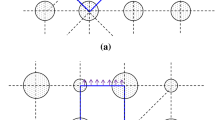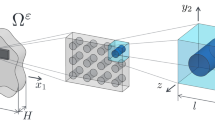Abstract
In this paper, the heat conductivity of two-dimensional (2D) media made of an arbitrarily thermal anisotropic material and containing pores with arbitrary shape and superconductive boundary is considered. In addition to the bulk behavior, the line conduction model is used for the boundary behavior. Such idealized mathematical model can be seen as the limit case of very thin material layer with very high conductivity. The fundamental heterogeneity problem in the micromechanics of a single void embedded in an infinite matrix with both boundary and bulk behavior is then investigated and solved with the complex variable and the Conformal Mapping (CM) techniques. The heterogeneity problem results are then used to obtain the effective heat conductivity of the porous material with different homogenization schemes.







Similar content being viewed by others
References
Yan, B.-D., Meilink, S., Warren, G., Wynblatt, P.: Water adsorption and surface conductivity measurements on alpha-alumina substrates. IEEE Trans. Compon. Hybrids Manuf. Technol. 10(2), 247 (1987)
Awakuni, Y., Calderwood, J.H.: Water vapour adsorption and surface conductivity in solids. J. Phys. D Appl. Phys. 5(5), 1038 (1972)
Boyle, J., Jones, K.: The effects of CO, water vapor and surface temperature on the conductivity of a SnO\(_2\) gas sensor. J. Electron. Mater. 6, 717 (1977)
Cox, D., Fryberger, T., Semancik, S.: Oxygen vacancies and defect electronic states on the SnO2(110)-1\(\times \) 1 surface. Phys. Rev. B 38, 2072 (1988)
Williams, O., Jackman, R.: Surface conductivity on hydrogen terminated diamond. Semicond. Sci. Technol. 18, S34 (2003)
Huy, H.P., Sanchez-Palencia, E.: Phénomènes de transmission à travers des couches minces de conductivitéélevée. J. Math. Anal. Appl. 47, 284 (1974)
Hashin, Z.: Thin interphase/imperfect interface in conduction. J. Appl. Phys. 89(4), 2261 (2001)
Benveniste, Y.: A general interface model for a three-dimensional curved thin anisotropic interphase between two anisotropic media. J. Mech. Phys. Solids 54(4), 708 (2006)
Eshelby, J.D., Peierls, R.E.: The determination of the elastic field of an ellipsoidal inclusion, and related problems. Proc. R. Soc. Lond. A 241(1226), 376 (1957)
Mori, T., Tanaka, K.: Average stress in matrix and average elastic energy of materials with misfitting inclusions. Acta Metall. 21(5), 571 (1973)
Torquato, S.: Random Heterogeneous Materials: Microstructure And Macroscopic Properties. Springer, Berlin (2001)
Mura, T.: Micromechanics of Defects in Solids, vol. 3. Springer, Berlin (1993)
Stroh, A.N.: Dislocations and cracks in anisotropic elasticity. Philos. Mag. J. Theor. Exp. Appl. Phys. 3(30), 625 (1958)
Rao, K., Rao, M Bapu, Ariman, T.: Thermal stresses in plates with circular holes. Nucl. Eng. Des. 15, 97 (1971)
Gao, C.F., Zhao, Y.T., Wang, M.Z.: An exact and explicit treatment of an elliptic hole problem in thermopiezoelectric media. Int. J. Solids Struct. 39(9), 2665 (2002)
Zhang, A., Wang, B.: Explicit solutions of an elliptic hole or a crack problem in thermoelectric materials. Eng. Fract. Mech. 151, 11 (2016)
Chen, W.T.: Plane thermal stress at an insulated hole under uniform heat flow in an orthotropic medium. J. Appl. Mech. 34(1), 133 (1967)
Hasebe, N., Inohara, S.: Stress analysis of a semi-infinite plate with an oblique edge crack. Ingenieur-Archiv 49, 51 (1980)
Hasebe, N., Tomida, A., Nakamura, T.: Thermal stresses of a cracked circular hole due to uniform heat flux. J. Therm. Stresses 11, 381 (1988)
Hasebe, N., Chen, Y.: Stress intensity solutions for the interaction between a hole edge crack and a line crack. Int. J. Fract. 77, 351 (1996)
Chao, C., Shen, M.: Thermal stresses in a generally anisotropic body with an elliptic inclusion subject to uniform heat flow. J. Appl. Mech. 65, 51 (1998)
Qin, Q.H.: General solutions for thermopiezoelectrics with various holes under thermal loading. Int. J. Solids Struct. 37(39), 5561 (2000)
Vinh, P., Hasebe, N., Wang, X., Saito, T.: Interaction between a cracked hole and a line crack under uniform heat flux. Int. J. Fract. 131, 367 (2005). https://doi.org/10.1007/s10704-004-7138-3
Jafari, M., Jafari, M.: Thermal stress analysis of orthotropic plate containing a rectangular hole using complex variable method. Eur. J. Mech. A. Solids 73, 212 (2019)
Gurtin, M.E., Murdoch, A Ian: A continuum theory of elastic material surfaces. Arch. Ration. Mech. Anal. 57(4), 291 (1975). https://doi.org/10.1007/BF00261375
Doan, T., Le-Quang, H., To, Q.D.: Effective elastic stiffness of 2D materials containing nanovoids of arbitrary shape. Int. J. Eng. Sci. 150, 103234 (2020)
Doan, T., Le-Quang, H., To, Q.D.: Coupled molecular dynamics and micromechanics study of planar elastic properties of graphene with void defects. Mech. Mater. 147, 103450 (2020)
Muskhelishvili, N.: Singular Integral Equations: Boundary Problems of Function Theory and Their Application to Mathematical Physics. Courier Corporation, New York (2008)
Neuber, H., Savin, G. N.: Stress Concentration around Holes. XI + 430 S. m. 208 Abb. u. 77 Tafeln. Oxford/London/New York/Paris 1961. Pergamon Press. Preis geb. 84 s. net. ZAMM - Journal of Applied Mathematics and Mechanics/Zeitschrift für Angewandte Mathematik und Mechanik 42(6), 265 (1962)
Driscoll, T.: Algorithm 756; a MATLAB toolbox for Schwarz–Christoffel mapping. ACM Trans. Math. Softw. 22, 168 (1996). https://doi.org/10.1145/229473.229475
Le Quang, H., Bonnet, G., He, Q.C.: Size-dependent Eshelby tensor fields and effective conductivity of composites made of anisotropic phases with highly conducting imperfect interfaces. Phys. Rev. B 81, 64203 (2010)
Yvonnet, J., He, Q.C., Toulemonde, C.: Numerical modelling of the effective conductivities of composites with arbitrarily shaped inclusions and highly conducting interface. Compos. Sci. Technol. 68(13), 2818 (2008)
Author information
Authors and Affiliations
Corresponding author
Ethics declarations
Conflict of interest
We declare that we have no conflict interests in relation with the paper.
Additional information
Publisher's Note
Springer Nature remains neutral with regard to jurisdictional claims in published maps and institutional affiliations.
Appendices
Appendix A: Expressions in transformed coordinates
For heat transfer problem, the temperature T must satisfy the following energy conservation equation of the matrix phase with thermal conductivity tensor \(\mathbf {K}^0 = \begin{bmatrix} K^0_{11} &{} 0 \\ 0 &{} K^0_{22} \end{bmatrix}\)
In the conventional complex plane where \(z=x+i\sqrt{K^{0}_{11}/K^{0}_{22}}y\), the temperature T can be expressed in the following form
where \(\varphi (z)\) is an analytical function of z. The heat flux q can be expressed by \(q = q_x - i\sqrt{K^{0}_{11}/K^{0}_{22}}q_y\) with
Next, by introducing the new variable \(\zeta \) and by using the transformation \(z=\omega (\zeta )\), the function \(\varphi (z)\) becomes
In general, the mapping function \(z=\omega (\zeta )\) is chosen to map a void plate with boundary \(\varGamma \) in z plane into the unit disk in \(\zeta \) plane (\(|\zeta |\le 1\)) and solve the problem with \(\zeta \) as variable.
On the unit circle mapped from \(\varGamma \), we pose \(\zeta =e^{-i\theta }\) with \(\theta \) running from 0 to \(2\pi \). This parameterization also guarantees the arc coordinate s on \(\varGamma \) goes in the positive (counter-clockwise) direction. Differential calculus yields the following result
We can immediately obtain
and hence the three identities of (22, 23).
Appendix B: Detailed dimensions of voids
The details dimensions of all the voids are summarized in Fig. 8 where L is the basic dimension and for arbitrary shape, \(L_1=4.6L\) and \(L_2=2.5L\). All the results are to the value of L.
Rights and permissions
About this article
Cite this article
Doan, T., Le-Quang, H. & To, QD. Effect of void shape and highly conducting boundary on 2D conductivity of porous materials. Arch Appl Mech 91, 4539–4552 (2021). https://doi.org/10.1007/s00419-021-02014-z
Received:
Accepted:
Published:
Issue Date:
DOI: https://doi.org/10.1007/s00419-021-02014-z





